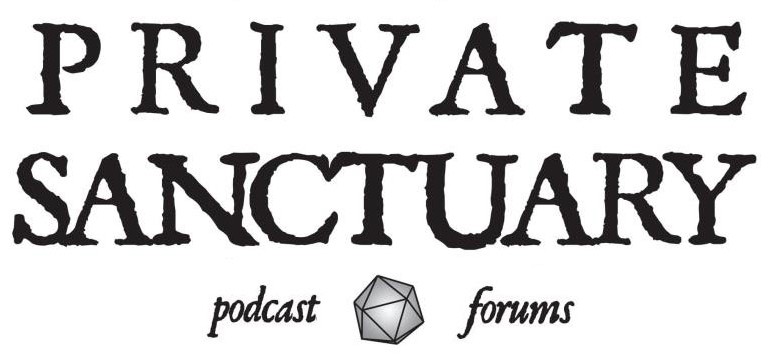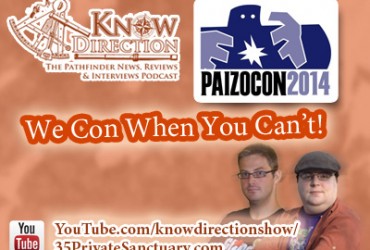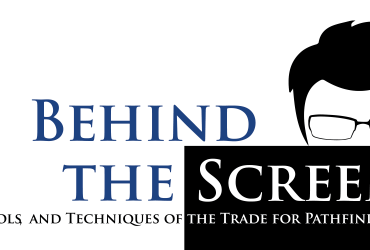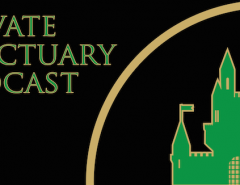It may seem like in every GMing episode, we pile another responsibility on the shoulders of our overburdened Game Masters. This episode might be the heaviest one yet. we talk about a GM’s social responsibility, with special guest co-host Tracy Hurley.
GMs have a lot of responsibility
SHOW NOTES
SPONSORS
When last we welcomed Tracy Hurley into the Private Sanctuary, it was based on her role as co-host of The Tome Show, a D&D podcast, to talk about skill challenges in Private Sanctuary 189. Today, we invite her on as blogger Sarah Darkmagic and advocate of equality in gaming. (http://www.sarahdarkmagic.com/)
Inclusivity has been a hot topic lately in gaming and broader geek hobbies, and many tabletop RPG companies have been taking aggressively pro-inclusive steps.
Paizo discussed it at length in their recent Diversity In Gaming seminar at PaizoCon and have been largely praised for supporting transgender fan Distracted Elf through their socially difficult coming out by way of Pathfinder products featuring transgender characters. And it’s heartening to see the predominantly positive response writer Crystal Frasier received for the new iconic shaman, Shardra Geltl.
WotC also took a bold step towards supporting inclusivity by wording the sex section of the new D&D rulebook to encourage playing across gender, and exploring homosexual, transgender, and asexual character ideas. There have been some debates about the wording but overall, WotC has been credited for their good intentions.
However, Tracy went deeper into the product and found fair gender representation to be lacking. What could a publisher of printed adventures, or a GM running a home game, do to create a more inclusive atmosphere?
Talking points:
- Hi Tracy!
- Why is inclusivity important?
- Commentary;
- Word choice and being too PC;
- D&D’s influence;
- Where did Lost Mines of Phandelver go wrong?
- Challenges of representation;
- Sexist plot versus sexist plotting;
- Trigger plots/creatures;
- Accommodating your players’ ideas, addressing your players’ intolerance.
Shout Outs:
Like The Private Sanctuary on Facebook.
Visit DriveThru RPG for all your RPG PDF needs.
This podcast is a member of RPG Podcasts.
Podcast: Play in new window | Download






This was a pretty great episode! I like how you guys break things down to more than just “Neckbeards Nerdbros in Fedoras VS Social Justice Warrior Feminazis” to a more realistic take on things. Gamers wanting clarifications? I’ve *never* heard of such a thing!
There’s a lot of good advice and talk in this episode, both for those of us who are trying and those who are on the fence – and even some for the people who don’t see the point of it. I actually play a non-binary character in PF and it did take a few sessions for some of the players to ‘get’ it. The point is they eventually did, and I don’t think that’s something that I could have pulled off even five years ago. I’ve been very pleased with the shift in the RPG community the last few years and it’s great to hear people talking about it and the importance of inclusivity at the table.
Thanks for this episode and I appreciate the tackling of more difficult or controversial issues that may affect PF games and even the larger gaming community. That being said, I do think that for an episode that was supposed to discuss inclusive GMing, the episode was probably too sensitive and politically correct to be very useful and I’ll try to break down and explain what I mean in this comment.
In the earlier part of the episode, there was some relevant discussion about avoiding stereotypes and expectations on players because it could actually have an effect on the players’ performances (which is important), however you failed to comment on what GMs can do when they do have those stereotypical types of players. Specifically for me, I was interested in this episode because the PF group that I am currently DMing for is half female players (4 of 8), but they all fit into the stereotype for female players (lacking experience, unfamiliar or even uninterested in the rules, and unable to stay focused through long skirmishes). I want to know what I can do to be more inclusive and orchestrate a game that draws in their attention more, allows them to engage with the rules at a level that they feel comfortable with, and enjoy playing even if they don’t understand things like optimizing their characters.
I just think that by trying to stray away from these stereotypes, you neglect to address probably the most salient problem concerning inclusive DMing (at least in my experience). That is not to say that I think that the stereotypes are useful (I very much agree that the expectations can affect performance) or that most or all female players fit into this category. Still, in my case, I would have liked some advice on how to GM in a way that better includes players like those described above (male or female). Perhaps the hosts felt it would be more appropriate to discuss these types of issues in more general terms (which you may have done in a different episode that I haven’t listened to) because at its core it is an issue of player temperaments not necessarily gender, but in my experience it is related to player genders and I’d like to grow as a DM in my ability to run a campaign that both male and female (steroetypical or not) can enjoy.
Well Miguel, let’s say gamers are all action figures, and the GM is in charge of packaging them. You could look at them all and say “this is what an action figure fits into,” and order all packaging to those specifications. And then you’ll get some figures that don’t fit that packaging. So if this is a Marvel Super Heroes line, your Captain Americas and Spider Mans and even Iron Mans will all fit the same package. But your Hulks, your Colossuses, your Things won’t.
In this case, a bit of stereotyping might work. Make a new package, an oversized package, and they’ll fit. But what if that fits Hulk and Thing but not Colossus? He’s as tall as the other oversized figures but not as wide; he might bust out of the regular package but fit loose in the oversized package.
So, you have four players who happen to be ladies and happen to lack experience. It happens. Heck, it probably happens a lot. If the stereotype is that lady gamers tend to act like newbs, and the hobby is doing what it can to bring more lady gamers into the hobby, then in this case there’s a self-fulfilling prophecy going on. You can try to adjust your one package in a way that fits them all, or you can ignore the fact that they’re all lady gamers and look at their individual motivations. I know if I treated Matt the same way I treated Corey when I GM, they would not respond the same way. Even though they’re both mid-30s straight married male Anglo-Quebecers with no kids and the same experience with the game. They’re different people. To go back to the action figure metaphor, one’s Captain America, one’s Human Torch. They’re so similar that they could be played by the same actor, but if Captain America’s packaging doesn’t have space for his shield, something’s missing. And if Human Torch’s package includes a shield, something doesn’t make sense.